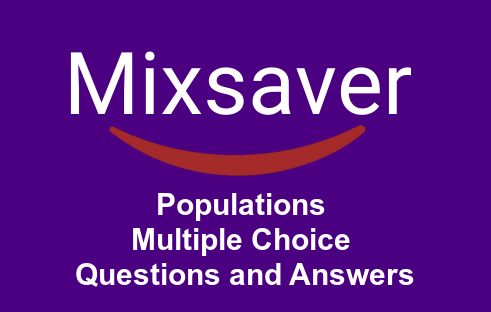Organisms and Populations Important Questions | Multiple Choice Questions on Population
1. The relationship between species and another within community that has evolved through interaction is based upon
(a) requirement and mode of obtaining food only
(b) requirement and mode of obtaining shelter only
(c) on the habits of the species only
(d) All of the above
Ans. d
2. Communities that exist in the aphotic zone ultimately depend on food manufactured by the chemoautotrophic bacteria or
(a) algae and cyanobacteria that also live in the aphotic zone
(b) algae and cyanobacteria that live in the photic zone
(c) decomposers
(d) minerals found on the ocean bottom
Ans. b
3. An association of different inter-related populations belonging to different species in common environment. which can survive in nature is called
(a) herd
(b) family
(c) population
(d) community
Ans. d
4. Why is a new island more hospitable to the colonisers than an older island?
(a) Competition is more intense on the newer island
(b) Predation is loss of a factor on older islands
(c) The extinction rate is higher on the newer island
(d) The intensity of both competition and predation is less on the newer island
Ans. d
Species Population Community Ecosystem Biome Biosphere | Population and Community Ecology | Ecological Population
5. Which of the following is an omnivore?
(a) Man
(b) Crow
(c) Both (a) and (b)
(d) Rat
Ans. c
6. Humans who have pets are healthier than humans, who do not have pets, which of these terms applies to the relationship between a human and a pet?
(a) Competition
(b) Parasitism
(c) Commensalism
(d) Mutualism
Ans. d
7. When the carrying capacity is equal to the population size, the net rate of increase in the population is equal to
(a) the carrying capacity
(b) less than zero
(c) the intrinsic rate of growth
(d) zero
Ans. d
8. The parasite, which come in contact with host for only a part of their life or occasionally at the time of feeding are called intermittent parasites. Which of the following is not an intermittent parasite?
(a) Leech
(b) Bed bug
(c) Female mosquito
(d) Ascaris
Ans. d
Organisms and Population NEET MCQ pdf
9. The animal, which captures and feeds on other animals is called
(a) predator
(b) prey
(c) parasite
(d) host
Ans. a
10. In world populations, individuals most often show a . pattern of dispersion.
(a) random
(b) density-dependent
(c) equilibrium
(d) clumped
Ans. d
11. Which of the following plants is not a predator plant?
(a) Hydrilla
(b) Drosera
(c) Utricularia
(d) Dionaea
Ans. a
12. The sum total of the populations of the same kind of organisms constitute
(a) colony
(b) genus
(c) community
(d) species
Ans. d
13. Intracellular endoparasite is
(a) Trichinella
(b) Plasmodium
(c) Trypanosoma
(d) Ascaris
Ans. b
14. A synthetic character of biotic community is
(a) fidelity
(b) dominance
(c) physiogamy
(d) All of these
Ans. d
MCQ on Population | Organism and Population mcq pdf | Multiple Choice Questions on Population Growth
15. Which one is a qualitative character?
(a) Abundance
(b) Frequency
(c) Biomass
(d) Phenology
Ans. d
16. A climax community is recognised by
(a) grasses, herbs and shrubs
(b) trees
(c) high biomass
(d) uniform composition
Ans. b
17. The phenomenon of having higher number of species in ecotone is called
(a) edge effect
(b) abundance
(c) frequency
(d) dominance effect
Ans. a
18. Wuchereria is a
(a) ectoparasite of man
(b) endoparasite of man
(c) predator of animals
(d) parasite of dog
Ans. b
19. What relationship persist between birds and cattle?
(a) Commensal
(b) Predator
(c) Protocooperation
(d) Mutualism
Ans. c
20. Female Anopheles visit the host for sucking blood at intervals. The type of parasitism is
(a) hemiparasite
(b) endoparasite
(c) holoparasite
(d) intermittent parasite
Ans. d
21. The type of relationship between sea anemone and hermit crab is
(a) commensalism
(b) mutualism
(c) symbiosis
(d) parasitism
Ans. b
22. Territory is defended against
(a) predator
(b) any intruder
(c) intruder of another species
(d) intruder of same species
Ans. b
Important Questions from Organisms and Populations | MCQ on Population Genetics | Population Ecology MCQ
23. Mycorrhiza, an association of fungus and angiospermic root is referred as
(a) ammensalism
(b) mutualism
(c) parasitism
(d) commensalism
Ans. b
24. The non-obligatory mutually beneficial relationship is represented by
(a) symbiosis
(b) protocooperation
(c) commensalism
(d) mimicry
Ans. b
25. Species interaction with negative influence on both is called
(a) predation
(b) parasitism
(c) ammensalism
(d) competition
Ans. d
26. An association of two species in which both species are benefitted is called
(a) protocooperation
(b) mutualism
(c) ammensalism
(d) All of these
Ans. b
27. Lichen is a symbiotic association of algae with
(a) protozoan
(b) fungi
(c) roots of plants
(d) bacteria
Ans. b
28. In aquatic mammals, a blubber is present
(a) in the skin
(b) around the different organs
(c) in the muscles
(d) in the connective tissue
Ans. d
29. The interdependent evolution of flowering plants and pollinating insects together is known as
(a) mutualism
(b) cooperation
(c) commensalism
(d) co-evolution
Ans. d
30. Exotic species sometimes become serious pest because of
(a) better environmental conditions in new locality
(b) better adaptability to new environment
(c) increase in reproductive potential
(d) the absence of natural competition
Ans. d





